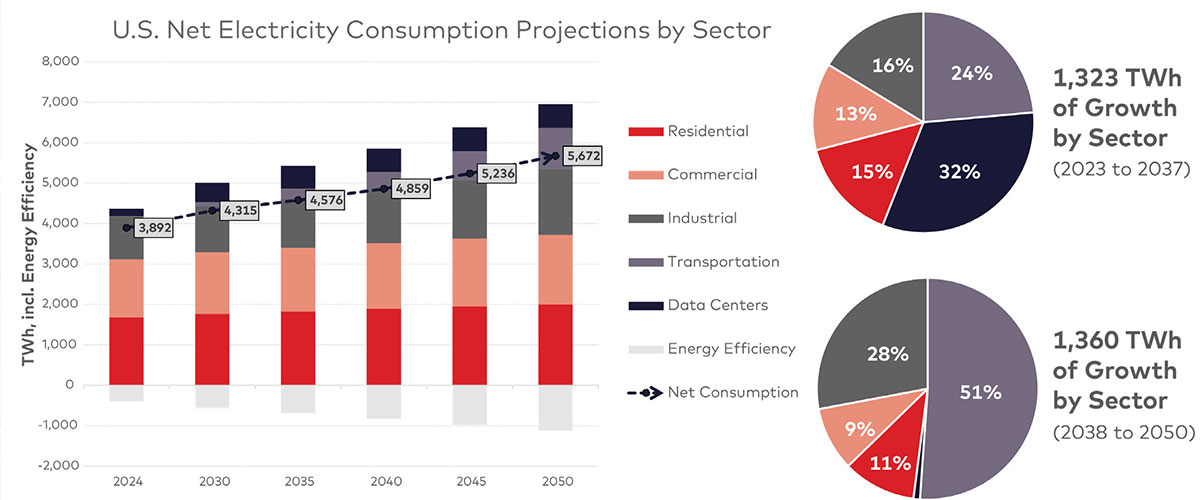People, Not Just Power: The Hidden Risk in Utility Contractor Management
The utility industry is facing a double challenge: high turnover and unprecedented load growth. Together, they heighten risks—injuries, cost overruns, quality issues, and delays.
Too often, companies focus only on who they hire, not how those contractors align with their safety culture. Real success takes more than filling roles—it requires intentional integration.
Is your organization prepared to adapt to change?

North America faces a significant increase in electricity demand, fueled by the growth of AI-powered data centers, a revival in domestic manufacturing and increased electrification in transportation, industrial processes, buildings and even homes.
In fact, the National Electrical Manufacturers Association estimates that electricity demand in the United States alone will increase by more than 50% by 2050.

Couple this with an aging power grid that increasingly is underfunded – the American Society of Civil Engineers projects a $3.7 trillion gap between current planned infrastructure investments and what’s needed for the nation’s infrastructure to be in working order – and the issue is worrisome.
Just as concerning, if not more, is that the greatest risk of rising electricity demand may not be technology, market shifts or interconnection delays. It’s people.
Utilities long have depended on contractors for major infrastructure projects, but a shrinking pool of skilled workers threatens both utility and contractor capacity.
In 2022, Brookings projected that from 2021 to 2031, 12% of infrastructure workers will leave their jobs each year on average – that’s about 1.7 million workers per year.
The challenge is real. On one hand is the increasing demand for electricity; on the other is an ever-decreasing supply of qualified and competent workers to handle the load.
As demand grows and qualified labor declines, utilities must rethink how they assess and manage this evolving workforce risk.
The Domino Effect of a Worker Shortage
Utilities face myriad challenges as they serve their communities in accommodating increasing power demands.
One key issue is building, maintaining or upgrading the infrastructure required to safely, reliably and affordably deliver energy to their customers. Utilities regularly rely on their contractor partners for planned daily work, responding safely to emergencies and for delivering large capital projects. While these partnerships always have been important, the shortage of competent, qualified craft workers in North America is making them more complex.
From a safety perspective, ensuring the people doing the skilled, consequential work are safe is critical to keeping the lights on and gas flowing. The worker shortage has contributed to people moving between companies more often (e.g., from utility to contractor, contractor to contractor and contractor back to utility) as better wages and opportunities arise. Rather than being able to build a culture of safety among a core – and consistent – group of workers, utilities find themselves starting over with their safety practices with a revolving door of contractors. Keeping track of competence, qualification and readiness to work is only going to get harder and harder to assess and track for a workforce constantly on the move. All of this is taking place against the recurring pattern of the ongoing turnover of experienced talent, who historically carried deep field knowledge, and the low attractiveness of utility work for the next generations (due to the highrisk nature of the jobs).
In short, the risk is the people. It’s important to note the people doing the work remain at the center of effectively managing safety and risk.
Utilities are known to have a strong focus on Serious Injury and Fatality (SIF) and overall safety. Despite a very high exposure to SIF on a daily basis, the industry has a reasonably low reportable injury rate. Conversely, the industry has a very high fatality rate.
Thinking Systemically about Contractor Management
The opportunity and the risk that must be addressed is clear: How do utilities ensure whoever is working on their infrastructure or at their behest is qualified, competent and prepared to complete their work safely, effectively, and following the appropriate work instructions?
Utilities have a variety of tools at their disposal to address their own employees (formal training programs, mandated qualifications programs, safety management systems, documented work procedures, regularly updated construction standards, etc.). But many times, there are significant gaps between resources available to a utility and the resources available to a small, local contractor.
The risk for utilities is in being certain their contractor partners are deploying all those same strategies just as effectively as the utility does. Utilities, broadly speaking, have made significant strides in the past 10 years in advancing their own risk awareness and safety culture.
The question now confronting them is how aligned are their safety cultures and risk awareness efforts with their contractor partners?
Historically, contractor management primarily has been thought of as cost containment, a job to hand off to an external partner, or a procurement risk to manage, but have also served to create a new layer of exposure. However, it is increasingly clear that issues like standard approaches to work, accessibility to shared standards, alignment of safety culture, shared KPI’s for safety and performance, contractor churn and multi-employer environments also need to be factored into how utilities establish, maintain, and monitor the health of their relationships with their contract partners.
As the reliance on one another deepens, finding lightweight and effective solutions that allow both parties to complete their work safely while providing each other appropriate assurance is only going to increase.

Are You At Risk?
Before utilities can make meaningful change in the contractors’ performance, they need to establish and then strengthen key foundations in their partnerships.
It starts with instituting management practices to enable performance improvement – a framework that includes people and organizations, processes and tools and systems – that can lead to a transformation. These critical foundations precede step changes that focus on making strategic approaches for outsourcing decisions, contracting plans and contractor plans. Transformation can take place when the strategic vision for contractor management ultimately leads to contractors feeling – and being seen – as an extension of the utility.
Other foundational elements are crucial.
Process – It’s important to introduce policy and procedures. One policy outlining the intent on managing contractor performance and a procedure for bringing clarity to expectations and requirements for each phase of the contractor management process provide an essential guide. Helpful sets of tools will equip workers with resources to facilitate the process.
System – Consistency is imperative. By using one global contractor management system, utilities can provide access to all stakeholders and engender a consistent way to manage and communicate with contractors.
People – Leadership ties it all together. The implementation of an owner organization that not only is capable, but also experienced and resourced, produces effective and efficient contractor management.
Once the foundation is stable, utilities can begin focusing on a holistic deployment approach to maximize impact and minimize disruption to areas that include capital planning, trailing impact to maintenance/readiness to operate and capability building.
Looking Ahead
The turnover trend the utility industry is experiencing is troubling when combined with historically large load growth. To make matters worse, it creates a domino effect that leads to even more risk and negative impacts like injuries and accidents; budget overruns and cost increases; poor technical quality; and delays.
All too often, organizations focus only on the first part of the equation (the people they contract) rather than the entire equation (how to ensure the people they contract blend into their broader organizational safety culture). The entire equation takes time, effort and intentionality.
Is your organization making the effort? Or is it time to reimagine the way it manages the contractors it so dearly depends on?
Author



